A tale of deception: My conversation with an FGC survivor in Pakistan

By Hina Javed (This is the third part in a series of essays by Hina Javed on her experience of reporting on FGC in Pakistan. Read the whole series here: Pakistan Journal.) The time had come to pick up that phone. Little did I know that my conversation with an FGC survivor would be more harrowing for me than the talk which revealed its existence to me in Pakistan. I picked up the phone and made contact with my second survivor, 37-year-old Sophia. The woman narrated the time when she, just a girl of seven, was led into a dimly-lit room, full of strange odors and even stranger people. This was not the shopping trip the minor had in mind when she was told earlier in the day that her aunt was taking her out. As if the surroundings were not distressing enough, the girl was forced to lie down on the floor and soon a complete stranger was reaching between her legs. The moment she was ‘cut’, she let out a loud scream and tears started rolling down her face. When it was over and done with, the matter was hushed up and never spoken of again. Three decades on, a now grown woman remembers vividly the day her freedom of choice was taken away: I still remember it distinctly. I feel slighted, even to this day, at how they held me down despite my attempts to push them [the strangers] away. But most of all, I feel angry at how they buried the matter under blankets of silence and pretended like it never happened. The day I walked out of the dingy apartment, I thought I was punished for being ‘bad’. I was mortified to look even look at the cut. I wanted to lie down in my mother’s lap and forget everything; to assume, for a split second, that what existed between my legs wasn’t shameful. When I grew up, I was finally able to connect the dots. The ‘cut’ was a symbol of my sexual submissiveness. Just like vaccinated animals, I was now wearing an imaginary ear tag signifying the death of the ‘parasite’ [or bug] driving my sexuality. From then on, I was to be categorised as a woman of ‘decent’ character. The truth is, I was just another offering to a centuries old tradition. The decisions made about my body came from a group of elderly women who believed it was a necessary rite of passage. And the cherry on top was that I was made to kiss my hostess’s hands as a gesture of respect. I didn’t speak about the incident for the longest time. I feared it would be considered rude and impolite. But there came a point when it became difficult to contain my angst and disappointment and I ended up asking my mother. I now realize that it wasn’t her fault either. I wonder if my anger towards my mother was even justified. Without a shadow of doubt, she was under immense pressure from family elders. If she tried to get away with it, they would have found out and ostracised her from the community. I am now a happily married woman with two beautiful children, but I feel a sense of deep remorse when I engage in sexual activity. I feel immoral, sinful and unclean. The trauma is so deep that the act itself becomes an unpleasant experience. It is difficult to be psychologically scarred and feel completely at ease. Sadly enough, our generation still believes sex is a dirty, reproductive act. We are trained to associate sexuality with immorality. We grow up with warnings that if we express our desires, we are deviant and dirty. We have spent our entire lives in the absence of this conversation, but we need to have it anyway. This avoidance has robbed several women of their identities. I have tried to bring this up many times with little progress. I am already estranged from my family over disagreements. What is surprising is that these decisions are made by women. The misogyny is so deeply internalized that they are unable to look squarely at the sexist world around them. Upon hearing Sophia’s story, I recognized the extent of psychological and physical damage the ‘cut’ had on her. She was in perpetual dilemma: on the one hand she wanted to speak up about her experience, but was also overcome with guilt and fear. It was evident that she was unable to shake off the impact of the incident to this day. As she finished speaking, there was a momentary pause as I struggled to thank her for speaking up about her experience. “I wish I could allow you to quote my name. There is a dire need to elevate this conversation in every country, especially Pakistan. However, there is immense pressure from my community due to which I want to remain anonymous,” she said. “I understand,” I replied. “I hope your story stirs a conversation and becomes a movement in this country. We need to put an end to this contested practice.” (*Sophia is a pseudonym. The person’s original name has been changed to protect her identity.) (Hina Javed is an investigative journalist based in Pakistan, driven by the ambition of tackling difficult, often untouched topics. Her focus is on stories related to human rights, health and gender.)
The unsolved riddle: conversations with survivors (Part 2)

By Hina Javed (This is the second part in a series of essays by Hina Javed on her experience of reporting on FGC in Pakistan. Read the whole series here: Pakistan Journal.) That night, after witnessing truth being replaced with the censor’s lie, I spent hours alone in my room, flinching at every little thought that crossed my mind. I sat on the tiniest corner of my bed, locked in a deep sulk. In the ensuing minutes and the quiet of that night, thoughts frantically raced through my head in an attempt to find the answer. Was the issue of female genital cutting (FGC) so intimidating that it could not be expressed aloud in the Pakistani media? Was this the way of patriarchy? It made you suffer in silence. I traced my steps back to where I had deviated from the norm. The more I struggled to solve the mystery of why my well-researched article on FGC in Pakistan was no longer going to be published, the more I was convinced that the questions would be put away in the recesses of my mind, like an unsolved riddle. In that instant, brief fragments of past conversations bubbled up in my consciousness. How bizarre it was that the reminders came flooding in at the very moment disorder took over my existence. I was now back to square one, having my first conversation with Amber* after she acknowledged the existence of FGC so matter-of-factly. “But why would you cut an innocent girl who is still tasting the sweetness of childhood?” I asked, trying to make sense of it all. “There is no harm in it,” Amber spoke with an indifference. “It makes the child pure for the rest of her life. We live in a sinful age where girls deviate when they hit puberty. Khatna is done to preserve their chastity and it’s a good thing!” I nodded, less in agreement, and more as a courtesy to show I was listening. “You know how in foreign lands girls explore their sexuality before tying the knot?” She said in an almost condescending tone. “Circumcised girls don’t indulge in such things.” Amber’s words hit me like a ton of bricks. We had been friends for some time now and frequently discussed women’s rights, consent, and feminism. In every conversation, it surprised me how much the two of us thought alike. However, this time I could not believe my ears as I listened to her justify female genital cutting. I held myself from lashing out in protest at her promoting FGC. As Amber’s friend, and not a journalist, I could have countered her justifications. But, I refrained from hurting her religious sentiments and gave her the benefit of doubt to see if I was missing a point. “But doesn’t it hurt a girl’s sexuality as she grows up?” I asked, my face scrunching up into an expression of worry. “What if your daughter doesn’t want this for herself?” “It doesn’t work like that,” Amber said, softening her tone. “There was a time when family elders used to mask reality and constantly take us by surprise. There was less communication and more innocence. But, when it came to my daughter, I mentally prepared her for it ahead of time.” I nodded, again less in agreement and more in courtesy. “The doctor asked me not to hide anything from my daughter. In fact, this doctor is so professional, she doesn’t circumcise girls without their consent.” “What was your daughter’s reaction like?” I asked in a muffled tone, full of disbelief at what Amber was telling me. “She was scared and had her fears, but she knew what was coming. After a few conversations, she made peace with it,” Amber went on. “My daughter will never blame me because I took her consent. Mothers who do it without their daughter’s consent are wrong, in my opinion. There is no harm in asking. They are girls. They will understand.” Listening to Amber made me realize how we, as a society, misunderstand the concept of consent. The definition of ‘consent’ is written in crayon; raw, unfinished, unprocessed. What is confusing to a great many people is that consent cannot be given by a minor who because of their age cannot grasp the full implications of what is happening to them. Consent is more than forcing a grudging “yes” out of someone; it means getting informed permission from a person when they have the reasoning capacities of an adult. This lack of understanding consent can cause a lifelong impact on a girl’s sexuality when they are an adult – one that is eternally painful. Amber and I gauged each other’s expressions with an uncertainty only we could discern. She was patient with my questions, but now I could feel a thought forming at the edge of her consciousness. She was wondering if perhaps I viewed her differently, thought negatively of her actions. She was starting to get a little frazzled. I changed the topic and asked her if I could call the following day. That night, I decided to pursue this topic as a story. I perused online resources and posted in a few closed forums to connect with more survivors. The mere thought of doing a thorough investigation on a topic as sensitive as FGC seemed far-fetched – almost impossible. I received several warnings from friends and colleagues asking me to back off. I didn’t. The next day, I brewed coffee, cleaned my work space, drafted the questions and called Amber. Since my journalistic hat was now on, I decided to remain neutral – barely interrupting her as she spoke. “Hello!” Amber said after picking up her phone. “Hi!” I responded. We waited for each other to fill the silence as if we had yet to discover the language in which we could really communicate on this topic. “I hope I am not being a bother,” I said after 60 seconds. “Not at all! Shoot me your questions, but
Sahiyo’s Mariya Taher receives Survivor Activist Award
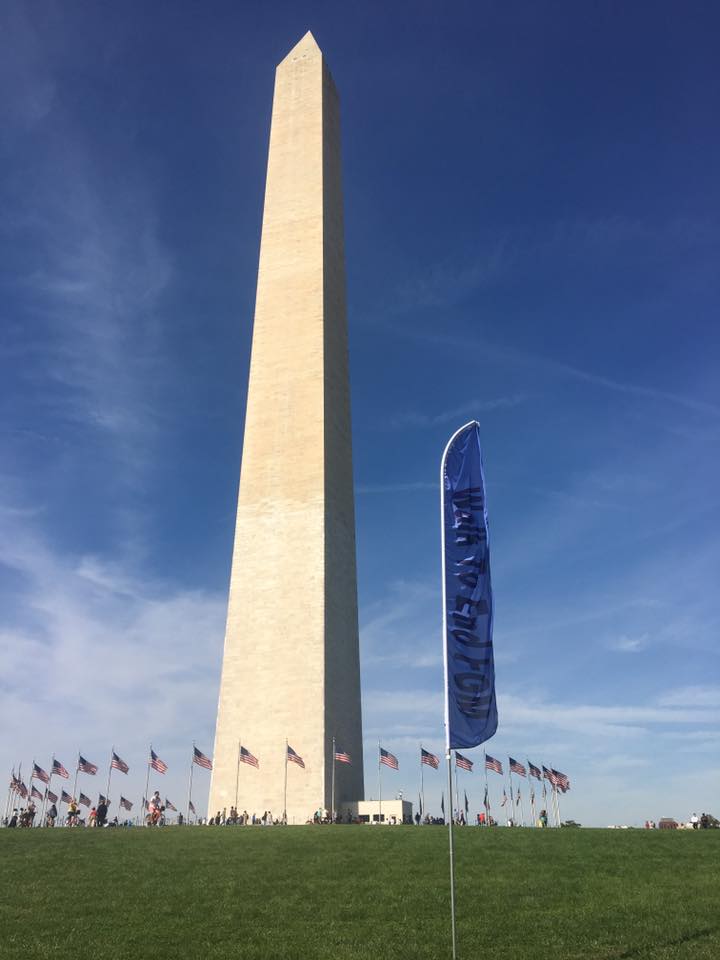
On Saturday, October 2, the Global Woman P.E.A.C.E. Foundation recognized Sahiyo Cofounder, Mariya Taher with the Survivor Activist Award at their annual 5K Walk to End FGM Charity Event in Washington DC. Mariya along with eight other deserving women and men were given Recognition Awards for the outstanding work toward ending female genital cutting and other injustices against women and girls during the pre-walk ceremony on the Washington National Mall in Washington, D.C. To learn more visit the Global Woman P.E.A.C.E. Foundation blog here.
Four American survivors of FGC speak out
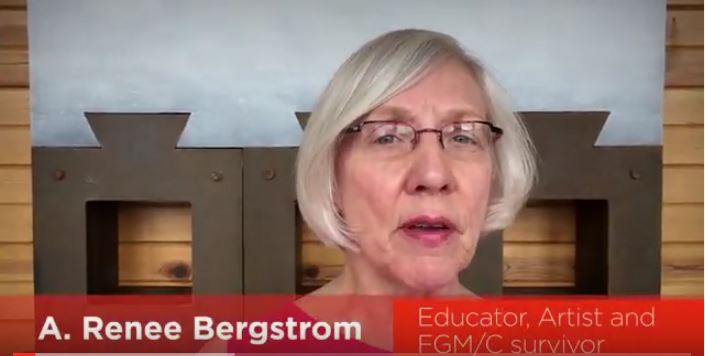
Four American survivors of Female Genital Cutting have broken the culture of silence around the issue through a new video. These women, from diverse backgrounds, illustrate that FGC is not restricted to any one geography, religion, or socioeconomic class. The four women featured in the video produced by the U.S. Department of State Bureau of International Information Programs include Renee Bergstrom, F.A. Cole, Aissata Camara, and Sahiyo co-founder Mariya Taher. In order to realize the UN Sustainable Development Goal of ending FGC by 2030, we need not only more courageous survivors need to speak out, but we also need religious leaders, men and boys, health practitioners, and young people to join the global campaign. To watch the video, click here.
Female Genital Cutting exists to preserve patriarchy: A Bohra survivor speaks out
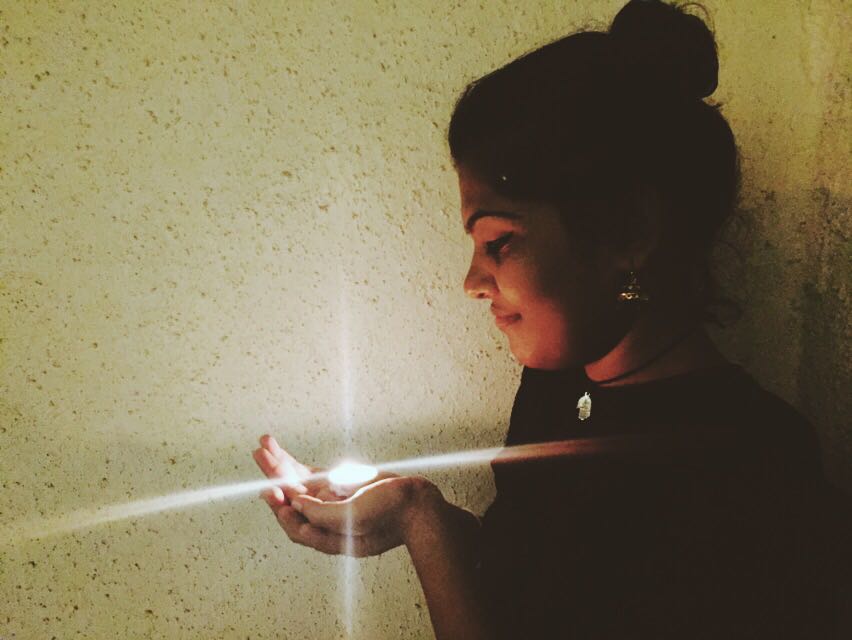
by Mubaraka MotiwalaAge: 18Country: India (This essay was first published on the Safe City blog on January 22, 2017) Female genital mutilation (FGM), also known as female genital cutting and female circumcision, is the ritual removal of some or all of the external female genitalia. Ever wondered why it’s done? Well I did and I found out what a heinous act it truly is. In the summer of 2016, I went for a vacation and discovered that I too was a victim of FGM. This came as a complete shock to me; like a repressed memory it just zapped my brain and froze my memory. I was in the bus having a conversation with one of my Muslim female friends and in the midst of talking about religion she suddenly asked me if I was circumcised? At first I was confused and gave it a good thought but nothing came to me, so I said, “no, that wouldn’t have ever happened to me’’. Saying this, we continued with our conversation. A month later a few people in my community started talking about it and I had a few college classmates come up to me asking me to be a part of the FGM movement or if I’ve experienced it. This led me to really think about this and finally when I was travelling back home one day the memory came rushing in and completely baffled me. I am in fact a victim of this preposterous act and was so utterly unaware and uneducated about it. I was tricked into thinking that I’ll be getting chocolate and instead was taken to a shady-looking dimly lit house, where a lady was waiting for me and my grandmother. The lady asked me to lie down and spread my legs, which was an extremely strange thing for me to do. But my consent and opinion wasn’t taken into account, of course. She pulled my panties down and told me to stay still and that I won’t be hurt at all while my grandmother sat there, watching. And then it happened, she cut my clit and put some antiseptic but that didn’t stop me from crying out in pain and have a bruised vagina. Finally, I was given the promised chocolate and taken back home to forget and mask the day’s event completely. So my question is, why do we perform this practice? Through my research I’ve found out that FGM is practiced by people because it is often considered necessary for raising a girl, and to prepare her for adulthood and marriage. It is often motivated by beliefs that it is imperative to perform this. It aims to ensure premarital virginity and marital fidelity and in many communities believed to reduce a woman’s libido and therefore believed to help her resist extramarital sexual acts so she can be loyal to her husband. FGM is carried out because it is believed that being cut increases marriageability and is associated with cultural ideals of femininity and modesty, which include the notion that girls are clean and beautiful after removal of body parts. Known as Khatna in certain communities, it is considered as a prestigious event and often celebrated and boosted by family members and society. But in reality I think this practice is performed in attempts to control women’s sexuality and ideas about purity, modesty and beauty. The reason behind all kinds of genital mutilation is to restrict female sexual experience. It is usually initiated and carried out by women itself who see it as a source of honour, and who fear that failing to have their daughters and granddaughters cut will expose the girls to social exclusion and generate rebellious nature. And to my complete utter surprise no religious scripts prescribe the practice. Practitioners often believe the practice has religious support and is good for female health but there are no known health benefits. So the truth is that nobody knows why we practice FGM but because it is imposed on us as a religious responsibility and as our ticket to be accepted and be married, we go along with it. Everybody has been lying to us telling us that this is the right thing to do and beneficial for our future. This entire malpractice is existent to ensure and preserve patriarchy in societies. Us women are always controlled by someone or something for our entire life. This kind of behavior makes us give in and accept the stereotypes that are actually abusive and violating to us. We are manipulated into submission and are to do what someone else commands us. Aren’t we all the creation of god and told that he gives us everything for a reason, then why take away our will and consent to decide if we want this to happen to us or not. What gives anybody the right to take away the will to have their own opinion and purloin a part of someone’s body parts. What gives another person the right to enforce such unacceptable and abysmal rituals! We need to stand up for ourselves, ladies, and show people that we’re not empty vessels and we can’t be controlled to do whatever another pleases. We are human too. Say no to Female Genital Mutilation.
FGM/C from an artist’s perspective: Art for cultural change

Underground in America: Female Genital Cutting
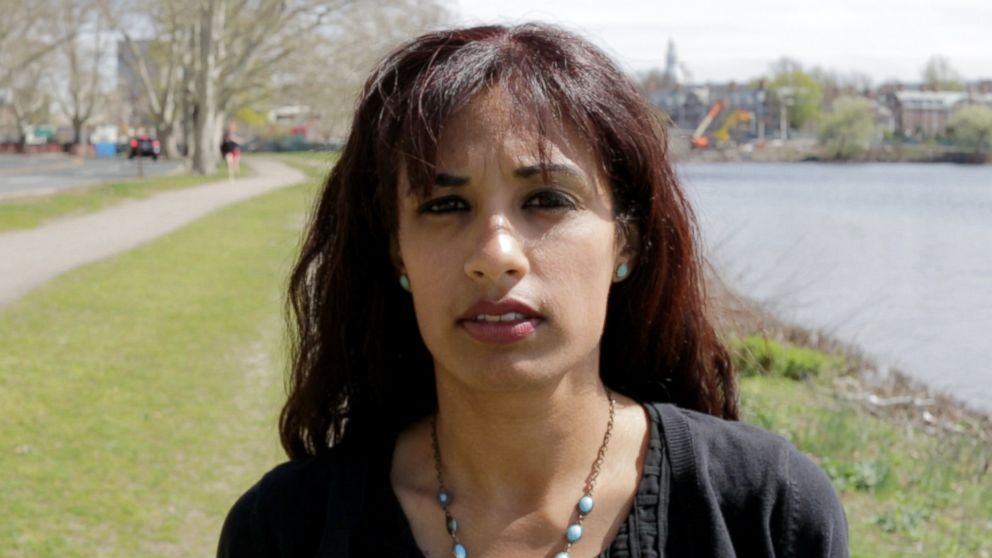
On June 22, 2016, Sahiyo’s cofounder, Mariya Taher came out on camera to discuss FGC in the United States and the work she has been doing to support other women and girls who are at-risk or who have undergone FGC and are living in this country. Her work into this area of gender violence began in 2008 when she started her Master of Social Work program at San Francisco University and decided to research FGC amongst immigrant communities living in the United States. Her motivation for pursuing this topic – she had undergone it herself at seven years old and understood the complexities involved with the practice. She understood that FGC was viewed as an obligatory social norm in the communities that practiced it and that it would be a challenge to help communities understand that this tradition was in fact, a form of gender violence, illegal in the United States, and against many existing human rights conventions. In 2015, she helped ABC news shed light on this practice by participating anonymously in their multimedia news piece, “Underground in America: Female Genital Mutilation”. The short video in the piece was subsequently nominated for a Webby Award in the category of Individual Short or Episode. Then in 2016, as the work of Sahiyo became more public and widespread, she showed her face on camera in the follow-up piece produced by ABC News, “Underground: Risk of FGM Increasing for Women in the U.S.”, says CDC. When asked why – “It took me eight years to decide to reveal my face on camera. I had researched and written about FGC in print for years, but revealing your face on camera is very different. It meant my personal life and professional life were enmeshing and I knew it also meant that my family could be on the receiving end of backlash from their religious community, and from others who did not understand the complexities of power and control when it comes to gender violence. I also understood that not everyone is able to come out and publicly speak out against it and there are many reasons that range from fear, concern for friends and family members, legal reasons, not wanting to be viewed as a victim, and more. They are all valid reasons. I had taken many years to work through all of the potential unintended consequences of speaking openly, and I knew that I had finally reached a place where I could be a support for others, and because I am a social worker, I had the knowledge and background of working in social services to understand how to go about creating them for women and girls at risk for or who had undergone FGC. This is what I hope to do and this is why I revealed my face on camera.
Sahiyo teams up with Breakthrough to shine a spotlight on stories from FGC survivors
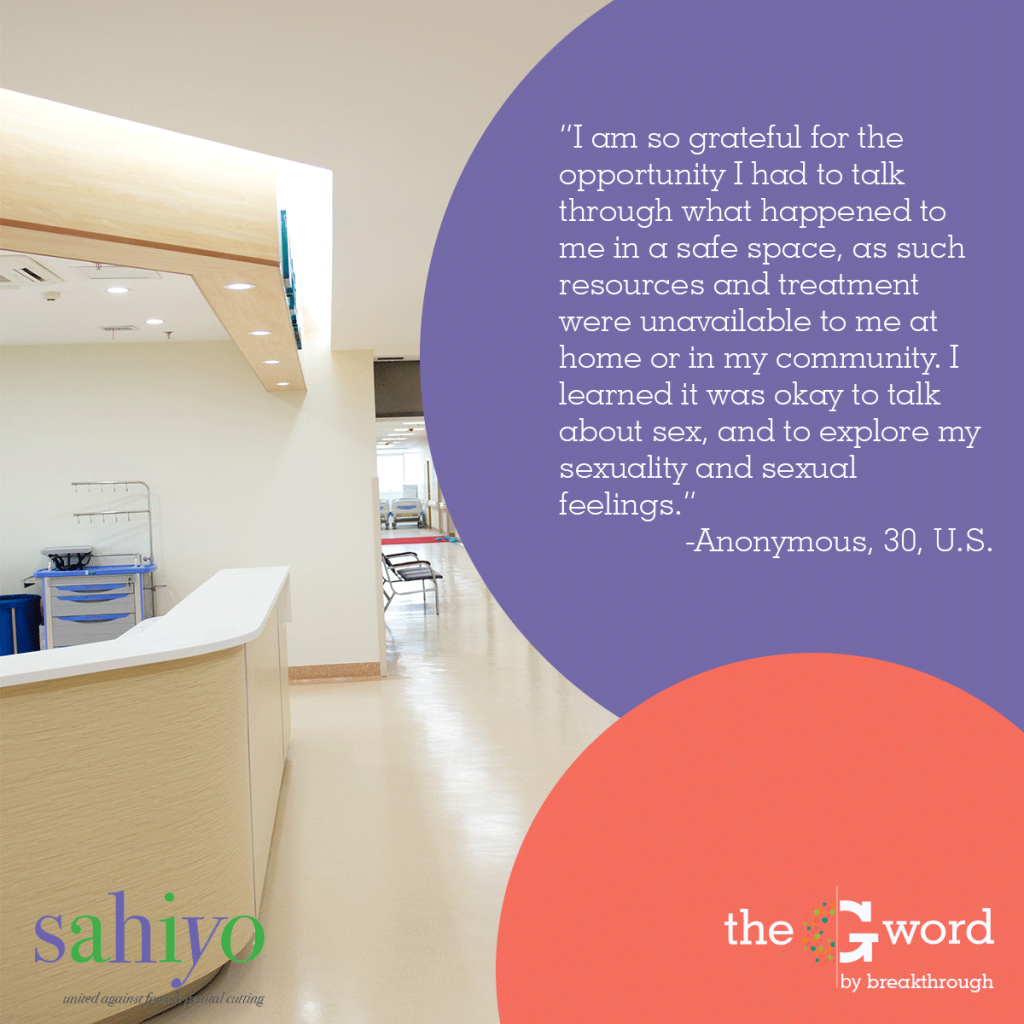
Art: A Tool for Healing and Dialogue with Communities Affected by FGM

By Naomi Rosen Female Genital Mutilation/Cutting (FGM/C), although often surrounded by secrecy and taboo, is now discussed more frequently in the media. Activist groups such as Sahiyo are taking great steps to heighten awareness and dialogue, within relational, familial, and community contexts, because the practice is often hidden, shameful, and the subject is therefore avoided. In many cultures and contexts, it is already difficult to talk about women’s bodies and women’s sexuality, but when talking about FGM/C, the discomfort and silence are compounded by generations of tradition, ideas about what it means to be feminine and pure, religious beliefs, and a multitude of other reasons dependent on geographical, cultural, religious, and personal contexts. Art is a helpful tool and medium in supporting communities affected by FGM/C to express and explore the topic of FGM/C in a way that feels less threatening and can allow for more openness and dialogue. Creative practices allow for what is secret and taboo to be brought to light. It encourages the exploration of what is unexplainable through words, and allows for the unheard to be spoken aloud, and for individuals to truly listen to and empathize with one another. Art can heal emotional wounds through the creation of meaning-making and metaphor. This year as a German Chancellor Fellow through the Alexander von Humboldt Foundation and under the guidance of Tobe Levin von Gleichen, I have been interviewing organizations and individuals in Germany, but also more broadly in Europe and the United States, to explore how the arts can serve as a tool for trauma healing and dialogue with communities affected by FGM/C and other forms of Gender-Based Violence. I have learned creative practices are utilized with communities affected by FGM/C and the unique role the arts can serve. The purpose of compiling this information through my various interviews is to create a handbook to support organizations, practitioners, and direct-service providers in utilizing art and creative approaches in their daily practice. The handbook seeks to expand the definition of “art” to include storytelling, gardening, cooking, and more. It will suggest unique ways to use the arts, from generating intergenerational dialogue to creating spaces for prevention and awareness-raising in gender violence. The resulting publication will also contain descriptions of the organizations I have interviewed and their contact information so that these organizations can be connected with one another and to other individuals for future collaboration and knowledge-sharing. While FGM/C is a custom that for generations has been hidden, the utilization of the arts can create the opportunity for healing from potential traumatic responses as a result of the practice, as well as fostering dialogue that may not be possible otherwise. For more information, please contact Naomi Rosen at naomirrosen@gmail.com For more information on Tobe Levin von Gleichen and her publishing company, UnCut Voices Press, visit the blog https://uncutvoices.wordpress.com ———————————————————————- Naomi Rosen lives in Frankfurt, Germany. After completing at B.S. in Theater at Northwestern University, she was a Northwestern University Public Interest Program Fellow (NUPIP), where she witnesses the role art and theater can play in healing and change in working with at-risk youth. She went on to pursue her Masters in Social Work at University of Chicago’s School of Social Service Administration where she specialized in Trauma-Informed Practice, Creative Arts Therapies, LGBTQ Affirmative Practice, and Multicultural, Multisystemic Practice with trainings at Live Oak Therapy Practice. Naomi is currently a German Chancellor Fellow through the Alexander von Humboldt Foundation where she is writing a handbook about arts-based methods to support communities affected by FGM and other forms of Gender-Based Violence.
Cafe Dissensus runs a special issue on female circumcision in the Bohra community
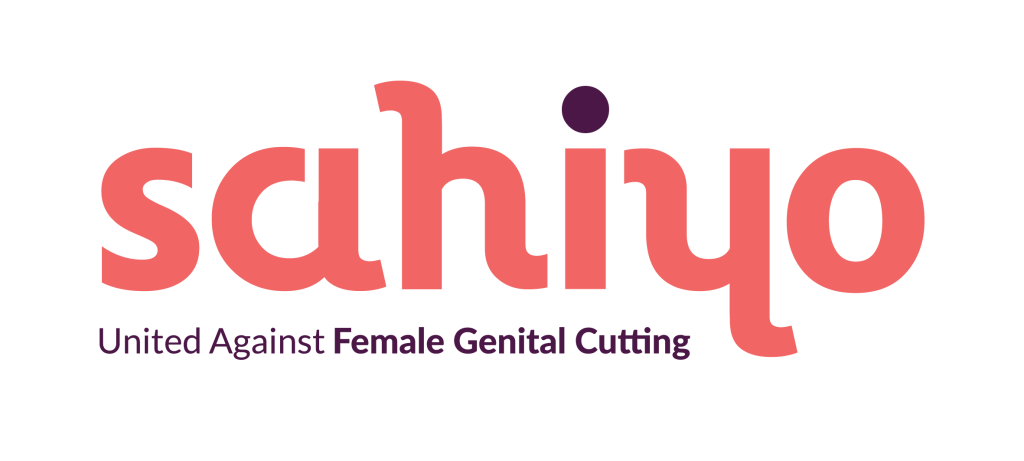
Cafe Dissensus, an alternative magazine about dissenting art, culture, literature and politics, has run a special May issue focusing solely on female genital cutting or khatna in the Dawoodi Bohra community. Guest-edited by Australian author Rashida Murphy, the FGC-special issue features fifteen essays and deeply personal stories by survivors of khatna and women who are driving the movement against the practice in the Bohra community. In her editorial, Murphy writes about her own escape from the cut and a tense summer in which she had to guard her young daughter from relatives who were keen to have her cut. Masooma Ranalvi, who founded Speak Out on FGM, discusses the anatomy of an unprecedented movement in the Bohra community. Dilshad and Shaheeda Tavawalla provide a comprehensive history of the Bohra faith and the fight against khatna. The many personal narratives of women who underwent the blade – Zehra, Sherebanu, Sultana, Zarine, Saleha, Fatema – reveal how long-lasting the trauma of khatna can be. The issue also features essays by various Sahiyo co-founders: Insia Dariwala speaks of survivor’s guilt and being “uncut“, Mariya Taher seeks to understand the burden of tradition, Aarefa Johari explores the relationship women have with their clitoris and in a joint essay, Mariya and Aarefa converse about the strength that survivors draw from each other. Read the full Cafe Dissensus issue here.
